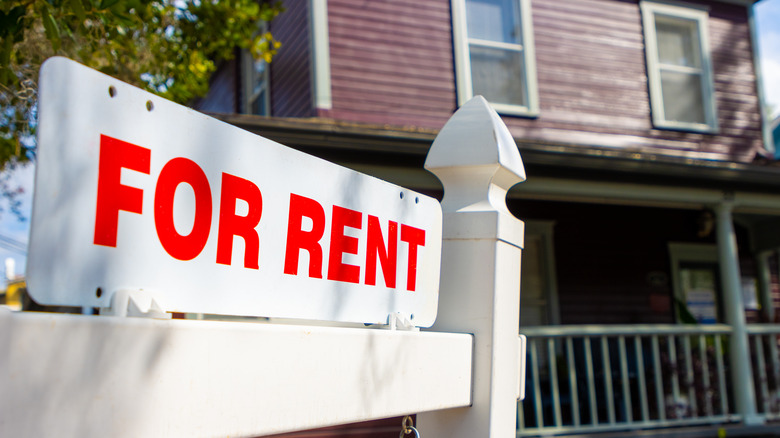Are You Paying Too Much For Rent? Here's How To Find Out
Arguably the most consuming and financially draining element of any American's budget today is housing. According to the Consumer Price Index, shelter (which includes rent and mortgages) has been increasing for 40 months straight. In fact, in early 2023 renters hit an all-time high by paying an average of 30% of their income on rent. Even though the general rule of thumb is to ensure that your rent is no more than 30% of your income (it's important to have an accurate understanding of your debt-to-income ratio before making your calculations), the 2023 average means that at least half of all American renters are paying too much for rent. Plus, while 30% might sound feasible enough, ever-increasing rent prices combined with lagging wages are making it increasingly impossible for Americans to maintain this budget rule.
For instance, a person living in New York City would have to make $18,666.67 a month to ensure that their rent only accounted for 30% of their total monthly income. (As of August 2023, the average rental rate in Manhattan was almost $5,600 a month, a 5.8 percent increase over 2022 and a 30% increase since 2019). This would subsequently also put them in the top 10% of American household incomes. While 30% of your income might have long been the rule for determining if your rent was too high, it's increasingly time to throw away that marker.
Are you paying too much?
Considering the factors in the current housing market, there is a good chance you are paying more than 30% of your income on rent. Plus, given current nationwide expenses, even if you are one of the people fortunate enough to actually pay only 30% of your income on rent, that amount is still proving to be unsustainable for many Americans. For instance, if you use specific financial techniques like, say, the 50/30/20 budget rule, then your rent would fall under the 50% of your budget that is devoted to your needs. If you maintain your rent at 30% of your total income, this leaves only 20% dedicated to everything else in your needs category which can include everything from healthcare to utilities to childcare.
Not only is keeping your rent at only 30% of your income becoming increasingly difficult, but maintaining the rest of your needs-based expenses at 20% is simply not possible for most people. This is especially true considering the astronomical cost of things like childcare (where, on average, families spend 27% of their income on childcare expenses) and the ever-increasing cost of healthcare (as of 2020, a person with workplace medical coverage faced a potential out-of-pocket medical total equal to 11.6% of their income, with 2021 per person health spending reaching $12,914). Plus, residential utility bills were up an average of 5% across the country in 2022 with electricity, in particular, experiencing a 13% increase in price from 2021 to 2022.
What can renters do?
If you do not belong to the more than 35% of Americans who rent, you might be asking yourself why people continue to rent if the prices keep rising. Unfortunately, entering the housing market has been made increasingly difficult for many Americans due to rising housing prices (there was an 18.7% increase between 2021 and 2022), rising interest rates, and, of course, rent increases that prevent people from saving the kind of money needed for homeownership. This leaves many families forced to continue renting, even as their rent becomes increasingly too expensive to actually afford.
By the end of 2022, seven specific metro areas had rent burdens greater than the 30% rule. The top rent-burdened cities in these areas include New York (with renters paying 64.9% of their income on rent), Miami (42.5%), Fort Lauderdale (37.3%), Los Angeles (35.2%), Palm Beach (34.4%), and Boston (33%). With that in mind, it can be important to remember that not all geographic areas are facing the same extreme housing costs as bigger cities and metros. For instance, nine states have experienced rent relief (with Maryland and Georgia recording rent declines), making them potentially more affordable options for financially strained renters. While it might sound extreme to move, renters are currently left with few options other than to consider more affordable geography. Plus, the growth of remote positions has made it more possible than ever to earn metro area-level income from somewhere with a more affordable cost of living.


